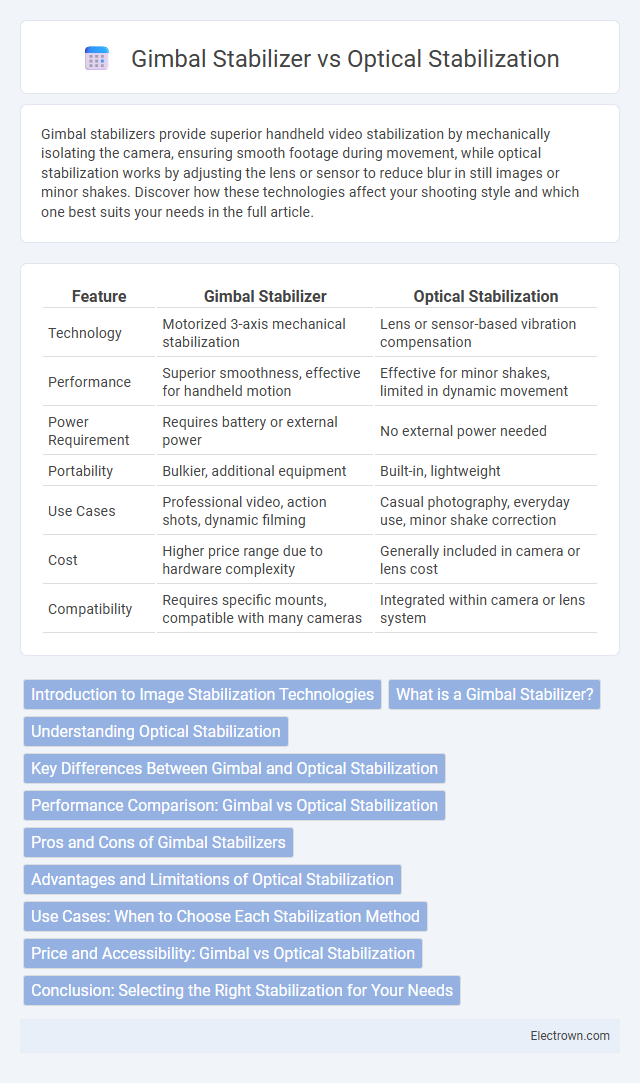Gimbal stabilizers provide superior handheld video stabilization by mechanically isolating the camera, ensuring smooth footage during movement, while optical stabilization works by adjusting the lens or sensor to reduce blur in still images or minor shakes. Discover how these technologies affect your shooting style and which one best suits your needs in the full article.
Table of Comparison
| Feature | Gimbal Stabilizer | Optical Stabilization |
|---|---|---|
| Technology | Motorized 3-axis mechanical stabilization | Lens or sensor-based vibration compensation |
| Performance | Superior smoothness, effective for handheld motion | Effective for minor shakes, limited in dynamic movement |
| Power Requirement | Requires battery or external power | No external power needed |
| Portability | Bulkier, additional equipment | Built-in, lightweight |
| Use Cases | Professional video, action shots, dynamic filming | Casual photography, everyday use, minor shake correction |
| Cost | Higher price range due to hardware complexity | Generally included in camera or lens cost |
| Compatibility | Requires specific mounts, compatible with many cameras | Integrated within camera or lens system |
Introduction to Image Stabilization Technologies
Image stabilization technologies play a crucial role in enhancing photo and video quality by reducing blurriness caused by camera shake. Gimbal stabilizers use motorized, multi-axis systems to counteract motion in real-time, providing smooth and steady footage even in dynamic environments. Optical stabilization, embedded in camera lenses or sensors, compensates for slight movements through lens element adjustments or sensor shifts, primarily improving clarity during handheld shots or low-light conditions.
What is a Gimbal Stabilizer?
A gimbal stabilizer is a mechanical device that uses motors and sensors to keep a camera steady during motion, ensuring smooth and jitter-free footage. It operates independently from the camera's internal stabilization system, providing multi-axis rotation control to counteract unwanted movements. In comparison, optical stabilization relies on lens or sensor shifts within the camera to reduce blur, whereas gimbals physically stabilize the entire camera rig for more dynamic and versatile shooting conditions.
Understanding Optical Stabilization
Optical stabilization involves adjusting the camera lens or sensor to counteract hand movements and vibrations during photography or videography, enhancing image clarity. It is typically integrated directly into lenses or sensors and works by shifting elements to compensate for motion, reducing blur without software intervention. This technology is essential for handheld shooting in low light or zoomed-in scenarios, maintaining sharp and stable visuals.
Key Differences Between Gimbal and Optical Stabilization
Gimbal stabilizers provide mechanical movement through motorized axes to counteract camera shake, offering smooth, 3-axis stabilization ideal for dynamic shooting conditions. Optical stabilization uses lens or sensor-shift technology to compensate for small hand movements, enhancing image sharpness without mechanical parts. Gimbals excel in full-motion stabilization, while optical stabilization is typically limited to minor vibrations and is integrated directly into the camera or lens system.
Performance Comparison: Gimbal vs Optical Stabilization
Gimbal stabilizers provide superior stabilization by physically counteracting camera movement through motorized axes, resulting in smooth and fluid footage even during rapid or complex motion. Optical stabilization, integrated into lenses or sensors, reduces blur by compensating for minor shakes and vibrations but is less effective in eliminating large, sudden movements. For professional video production requiring steady shots in dynamic environments, gimbals outperform optical stabilization in maintaining consistent visual stability.
Pros and Cons of Gimbal Stabilizers
Gimbal stabilizers offer superior stabilization by mechanically isolating your camera from unwanted movement, resulting in smooth, professional-quality footage even during dynamic motion. You experience increased versatility across various shooting scenarios, but gimbals tend to be bulkier, require battery power, and have a learning curve for effective operation compared to optical stabilization systems. While optical stabilization is integrated and relies on sensor or lens adjustments to minimize shake, gimbal stabilizers provide more fluid motion control but may add weight and complexity to your setup.
Advantages and Limitations of Optical Stabilization
Optical stabilization offers the advantage of reducing blur and camera shake directly within the lens or sensor, enhancing image clarity without requiring additional equipment. It is limited by the range of motion it can compensate for, often less effective during rapid or extreme movements compared to gimbal stabilizers. Optical stabilization also tends to be more compact and power-efficient, but may struggle in low light conditions or with dynamic action shots.
Use Cases: When to Choose Each Stabilization Method
Gimbal stabilizers excel in dynamic shooting scenarios such as action sports, walking shots, and cinematic panning, providing smooth and versatile stabilization for handheld video recording. Optical stabilization is ideal for still photography and general-purpose shooting, especially in low-light conditions or when using zoom lenses, as it compensates for minor hand movements within the camera or lens itself. Choosing between these methods depends on the need for mobility and flexibility versus convenience and compactness in capturing steady images or videos.
Price and Accessibility: Gimbal vs Optical Stabilization
Gimbal stabilizers generally have a higher price range, starting around $100 for basic models and reaching upwards of $600 for professional-grade units, making them less accessible to casual users. Optical stabilization is built directly into lenses or cameras, typically increasing the overall device cost by $50 to $200 but offering seamless integration without extra equipment. For budget-conscious buyers, optical stabilization provides a more compact, user-friendly solution, while gimbals offer superior stabilization at a higher initial investment.
Conclusion: Selecting the Right Stabilization for Your Needs
Choosing between a gimbal stabilizer and optical stabilization depends on your specific filming requirements and shooting environment. Gimbal stabilizers provide superior handheld stabilization for dynamic, moving shots, while optical stabilization excels in compact devices by reducing minor shakes during handheld shooting. Understanding your need for mobility, shot complexity, and budget will help you select the right stabilization to enhance your video quality effectively.
Gimbal Stabilizer vs Optical Stabilization Infographic

 electrown.com
electrown.com